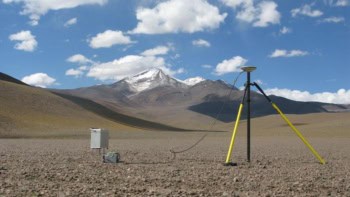
If it weren’t there, astronauts and satellites might well be showered with electrons at lethal energies. It’s “plasmaspheric hiss” — a natural radio wave that lies in just the right place outside the Earth to deflect high-energy electrons out of space and safely into the atmosphere. Since its discovery more than 40 years ago no–one has been sure of its origin, but now researchers from the US, Sweden and France claim to have the answer.
Having analyzed data from NASA’s THEMIS mission, Jacob Bortnik of the University of California at Los Angeles and colleagues think plasmaspheric hiss is generated by secondary “chorus” emission of electromagnetic waves from unstable electrons farther out. “I personally thought we would not be able to find such an observation,” says Bortnik. “Turns out I was pleasantly surprised.”
Helpful hiss
Scientists have long known that the Earth’s magnetic field traps high-energy particles, including electrons, into rotating regions that envelop the planet, called Van Allen belts. There are two belts and they are separated, between 10,000 and 20,000 km beyond the Earth, by the plasmasphere, where low-energy plasma rotates in the opposite direction. The plasmaspheric hiss is an electromagnetic wave of frequencies from 200 Hz to 2 kHz, and the magnetic component of it adds to the Earth’s magnetic field, thereby deflecting electrons from their normal trajectory and into the atmosphere.
There are three main hypotheses to describe how the hiss arises. The first is lightning, which with every strike creates an intense radio wave that can leak into space. The second, although unlikely, is that it comes from background magnetic turbulence, which gives energy in the form of unstable electron distributions that amplifies background radio noise. The third idea is also that the hiss grows from unstable electron distributions, but that these distributions reside just outside the plasmasphere and generate chorus hiss — a more intermittent type of hiss — that propagates inwards.
This last idea was developed by Bortnik’s group into a coherent theory last year, and it is the one the team now claim to have verified. They have analysed data from THEMIS, a constellation of five satellites that have different orbits around Earth and collect measurements of the electromagnetic environment. The researchers found that the hiss is not stronger over land, which is what one might expect if lightning were the cause because that is where there is more lightning activity. However, during a chance six–minute period when one satellite was monitoring in the plasmasphere region and another was monitoring farther out, they did find a correlation in modulation between plasmaspheric hiss and chorus hiss, which suggests the two are linked.
‘A large order’
Bortnik told physicsworld.com that it was “really tricky” to find this correlation. “We needed at least two satellites to be recording in high-resolution simultaneously — one in the distant chorus region, and the other in the nearby hiss region,” he explains. “We needed the waves to be present so we could observe them, and we needed the satellites to be oriented correctly with respect to Earth and each other. Quite a large order.”
However, he adds that many will not be satisfied with his group’s findings: “This has been an open problem for so long, and it has been so controversial, that to have a resolution is almost unpalatable.”
“I think we are only scratching the surface here and are about to get a truly Twenty-first Century view of the space environment we have been visiting since the 1960s,” he adds.
The research is published in Science.



